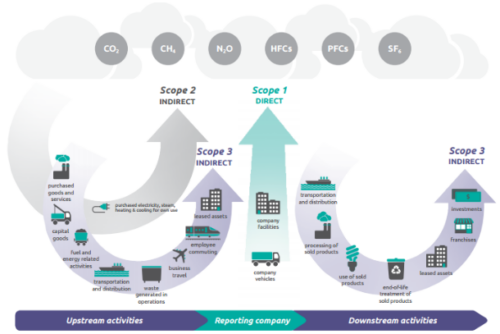
This current and important topic has many names. Emission calculation, carbon footprint, amount of greenhouse gases, carbon dioxide emissions, the GHG protocol, Scope 1, Scope 2 and Scope 3 emissions. In addition to a variety of terms, there is also a variety of calculation methods. Organisations face challenges in defining the way they calculate the amount of emissions caused by their activities. And their audience face challenges in understanding what exactly is being calculated.
What does carbon footprint describe?
”Carbon footprint” is a great term. It is very concrete. It creates a very strong image of the footprint and the impact caused to the environment by an organisation’s activities.
Carbon footprint describes the total amount of greenhouse gases created during the entire life cycle of an organisation, its activities or a product. Key greenhouse gases are carbon dioxide, methane, nitrous oxide, ozone and steam. In other words, carbon dioxide is only one of several greenhouse gas.
An organisation’s carbon footprint comprises its direct emissions, indirect emissions caused by its purchased energy and other indirect emissions in the entire value chain. This means that the footprint includes greenhouse gases created during the entire life cycle or value chain.
Usually, a carbon footprint is reported as carbon dioxide equivalents measured in units of mass, such as grams, kilograms or tonnes. Carbon dioxide equivalents include the effect all greenhouse gases have on warming the climate, calculated as equivalent impact of carbon dioxide. The objective is to be able to sum up the warming effect on the climate of all greenhouse gases, which are different for all of the different gases. Sometimes the carbon footprint will refer to only carbon dioxide emissions, instead of total greenhouse gas emissions. This can easily cause confusion and make it more difficult to understand the messaging.
Carbon footprint considering the entire value chain
Depending on the company’s sector and product selection, the other indirect emissions cause the most challenges. Due to the differences between sectors and value chains, there is no direct formula for the calculation of emissions created in the value chain. Globally there are many models for calculating carbon footprints, but no single, unambiguous way exists that would be suitable for all companies.
There is a variety of projects for calculating the carbon footprint of various sectors. The objective of these projects is to promote calculation work by companies in the sector while harmonising the calculation methods in order to make the carbon footprint of various companies somewhat comparable.
The Natural Resources Institute Finland collaborates with various actors in the food industry in order to harmonise calculation methods on the national level.
The challenge with understanding these terms is that the term “carbon footprint” is sometimes used imprecisely. Sometimes, it is not defined clearly which emissions are included in the calculation of the footprint.
Emission calculation in accordance with the GHG protocol
The most widely used, global accounting and reporting standard for establishing emissions is the Greenhouse Gas (GHG) protocol. The GHG protocol provides a cohesive structure for the calculation and reporting of emissions.
The method defines the principles for emissions reporting regarding seven greenhouse gases: carbon dioxide (CO2), methane (CH4), nitrous oxide (N2O), hydrofluorocarbons (HFCs), perfluorocarbons (PCFs), sulphur hexafluoride (SF6) and nitrogen trifluoride (NF3).
Global warming potential (GWP) is used to make the various greenhouse gas emissions comparable.
The GHG protocol divides the emissions caused by the organisation’s activities into three classifications (Scope 1, 2 and 3 emissions), which clarify which parts of the value chain have been included in the calculation.
- Scope 1: includes direct emissions of the company or organisation, created by their own energy production and vehicles owned or controlled by the organisation. Emissions not included in the Kyoto protocol (such as CFC and NOx) are not included in Scope 1 emissions, but they can be reported separately.
- Scope 2: emissions caused by purchased energy (electricity, heating, steam and cooling)
- Scope 3: All indirect emissions related to the company’s activities, caused by emission sources that are not owned or controlled by the company. Scope 3 emissions are further divided into upstream and downstream emissions.

Source: https://ghgprotocol.org/sites/default/files/standards/Corporate-Value-Chain-Accounting-Reporing-Standard_041613_2.pdf
Scope 3 upstream emissions include emissions caused by the production of purchased goods and services, which are divided into the following classes:
- Purchased goods and services
- Capital goods
- Fuel and energy related activities not included in Scope 1 or Scope 2 emissions
- Transportation and distribution
- Waste generated in operations
- Business travel
- Employee commuting
- Leased assets
Scope 3 downstream emissions include emissions caused by the use sold goods and services, which are divided into the following classes:
- Transportation and distribution
- Processing of sold products
- Use of sold products
- End-of-life treatment of sold products
- Leased assets
- Franchises
- Investments
The Corporate value chain (Scope 3) standard of the GHG protocol provides more detailed instructions for calculating the emissions of the value chain.
The principles of the GHG protocol are relevance, consistency, transparency, completeness and accuracy. These principles are quite familiar from the framework of the Global Reporting Initiative (GRI) sustainability reporting. GRI also utilises the GHG protocol in its reporting principles.
The Science Based Targets initiative also guides emission calculation in accordance with the GHG protocol.
The objective affects which emissions should be calculated
What principles should be taken into account in calculating emissions? Should the basic principle of materiality, familiar from corporate sustainability, be applied and only emissions from the most significant sources be included? Or maybe direct emissions caused by the organisation’s own activities? Or should you calculate the carbon footprint, including all emissions created during the life cycle of the entire organisation?
The objective and purpose for which you are calculating emissions affects which emissions should be counted. Is the goal to identify the most significant emission sources of the organisation and aim to systematically reduce them? Emission calculation is the first step in reducing greenhouse gas emissions. However, in this case it is not appropriate to calculate and systematically follow up changes in activities that create very little emissions.
Or is the objective to understand the environmental load of the entire organisation or a chosen product and utilise that in communications and marketing? This allows consumers to choose less carbon-intensive options. In this case the task is to establish and maintain carbon footprint calculation for the entire life cycle.
Remember the objective, transparency and activity
In this jungle of terminology and calculation methods, you should keep in mind the objective and purpose of emission calculation. It is also essential to communicate the results of emission calculation as transparently as possible to make it clear for the target group what is in included in the accounting. This is important to avoid misunderstandings and the feel of greenwashing.
In order for the audience to understand what is presented to them, you should aim to make the results of the emission calculation somehow comparable. It would be great if organisations could express the amount of emissions in concrete terms, compare the level of emissions to the general level or express the trend of how their emissions have been reduced.
When it comes to communication and transparency, terminology does matter.
But whichever terms you choose to use, emission calculation and understanding the emission sources is a significant first step towards the reduction of emissions. And emission reduction is the most important task of all.
**
If your company would like to gather data in order to calculate the emissions of its own activities as well as the various actors of the value chain please contact us.


































